DRAG DROP
-
You have an Azure virtual machine named VM1 that runs SUSE Linux Enterprise Server (SLES) and hosts an SAP NetWeaver application server.
You need to install the Azure VM extension for SAP solutions on VM1.
Which three actions should you perform in sequence? To answer, move all actions from the list of actions to the answer area and arrange them in the correct order.

DRAG DROP
-
You need to deploy an SAP production landscape on Azure. The solution must be supported by the SAP production landscape and must minimize costs.
Which Azure virtual machine series should you use for each SAP workload? To answer, drag the appropriate series to the correct workloads. Each series may be used once, more than once, or not at all. You may need to drag the split bar between panes or scroll to view content.
NOTE: Each correct selection is worth one point.

You have an SAP landscape on Azure that contains the virtual machines shown in the following table.
You need to ensure that the Application Server role is available if a single Azure datacenter fails.
What should you include in the solution?
B
You have an Azure subscription that contains an SAP landscape. The landscape uses Azure AD user authentication.
You need to configure single sign-on (SSO) authentication for SAP HANA and SAP Cloud Platform. The solution must support conditional access policies.
What should you configure?
C
You have an Azure subscription.
You deploy Active Directory domain controllers to Azure virtual machines.
You plan to deploy Azure for SAP workloads.
You plan to segregate the domain controllers from the SAP systems by using different virtual networks.
You need to recommend a solution to connect the virtual networks. The solution must minimize costs.
What should you recommend?
C
You can create custom, or user-defined, routes in Azure to override Azure's default system routes, or to add additional routes to a subnet's route table. In Azure, you create a route table, then associate the route table to zero or more virtual network subnets.
Incorrect Answers:
D: ExpressRoute is a costly solution.
You deploy an SAP environment on Azure.
Your company has a Service Level Agreement (SLA) of 99.99% for SAP.
You implement Azure Availability Zones that have the following components:
✑ Redundant SAP application servers
✑ ASCS/ERS instances that use a failover cluster
Database high availability that has a primary instance and a secondary instance
You need to validate the high availability configuration of the ASCS/ERS cluster.
What should you use?
B
Incorrect Answers:
C: You can use SAPControl to start or stop an SAP system from the command line.
References:
https://docs.microsoft.com/en-us/azure/architecture/reference-architectures/sap/sap-netweaver
HOTSPOT -
You have an on-premises SAP environment. Application servers run on SUSE Linux Enterprise Server (SLES) servers. Databases run on SLES servers that have
Oracle installed.
You need to recommend a solution to migrate the environment to Azure. The solution must use currently deployed technologies whenever possible and support high availability.
What should you include in the recommendation? To answer, select the appropriate options in the answer area.
NOTE: Each correct selection is worth one point.
Hot Area: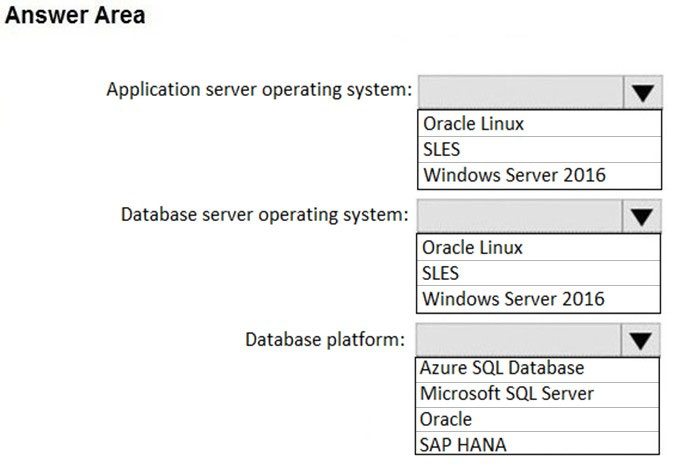
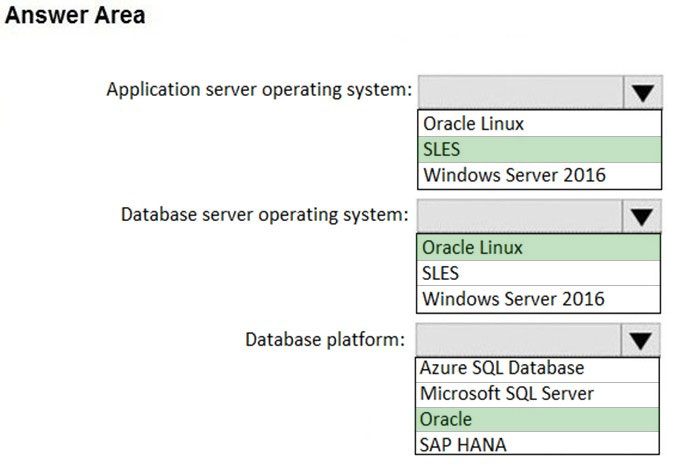
DRAG DROP -
You have an SAP environment on Azure.
You use Azure Recovery Services to back up an SAP application server.
You need to test the restoration process of a file on the server.
Which three actions should you perform in sequence? To answer, move the appropriate actions from the list of actions to the answer area and arrange them in the correct order.
Select and Place:

Step 1: From Azure Recover Vault, select File Recovery
To restore files or folders from the recovery point, go to the virtual machine and choose the desired recovery point.
Step 2: Download and run the mount disk executable
Step 3: recover the file and unmount the disk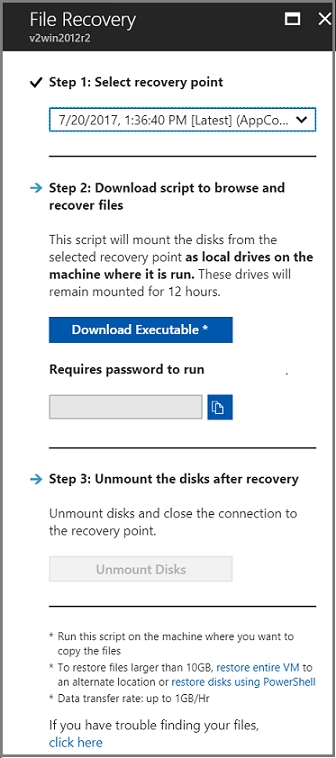
Reference:
https://docs.microsoft.com/en-us/azure/backup/backup-azure-restore-files-from-vm
This question requires that you evaluate the underlined text to determine if it is correct.
When deploying SAP HANA to an Azure virtual machine, you can enable Write Accelerator to reduce the latency between the SAP application servers and the database layer.
Instructions: Review the underlined text. If it makes the statement correct, select `No change is needed`. If the statement is incorrect, select the answer choice that makes the statement correct.
D
To further reduce network latency between Azure VMs, we [Microsoft] recommend that you choose Azure Accelerated Networking. Use it when you deploy Azure
VMs for an SAP workload, especially for the SAP application layer and the SAP DBMS layer.
Incorrect Answers:
A: Write Accelerator is a disk capability for M-Series Virtual Machines (VMs) on Premium Storage with Azure Managed Disks exclusively. As the name states, the purpose of the functionality is to improve the I/O latency of writes against Azure Premium Storage.
B: Mellanox offers a robust and full set of protocol software and driver for Linux with the ConnectX EN family cards. Designed to provide a high performance support for Enhanced Ethernet with fabric consolidation over TCP/IP based LAN applications. The driver and software in conjunction with the Industry's leading
ConnectX family of cards achieve full line rate, full duplex of up to 100Gbps performance per port.
C: To analyze network issue or measure network metrics you can test the connection using SAP's NIPING program. You can use NIPING to analyze the network connection between any two machines running SAP software.
Reference:
https://docs.microsoft.com/en-us/azure/virtual-machines/workloads/sap/dbms_guide_general
HOTSPOT -
For each of the following statements, select Yes if the statement is true. Otherwise, select No.
NOTE: Each correct selection is worth one point.
Hot Area: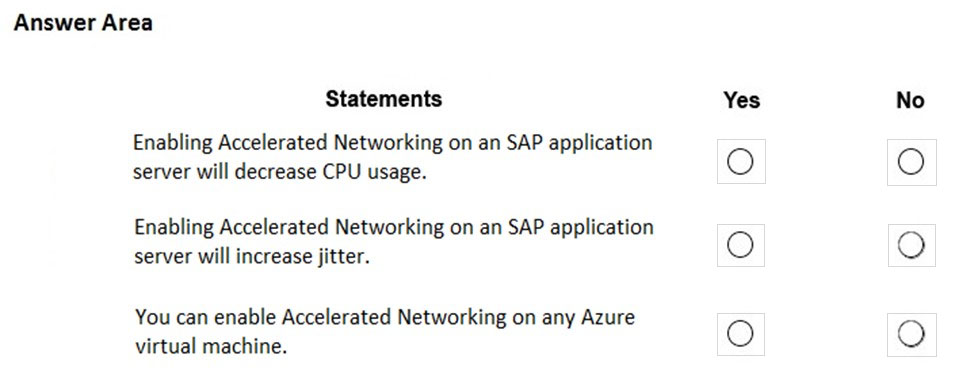
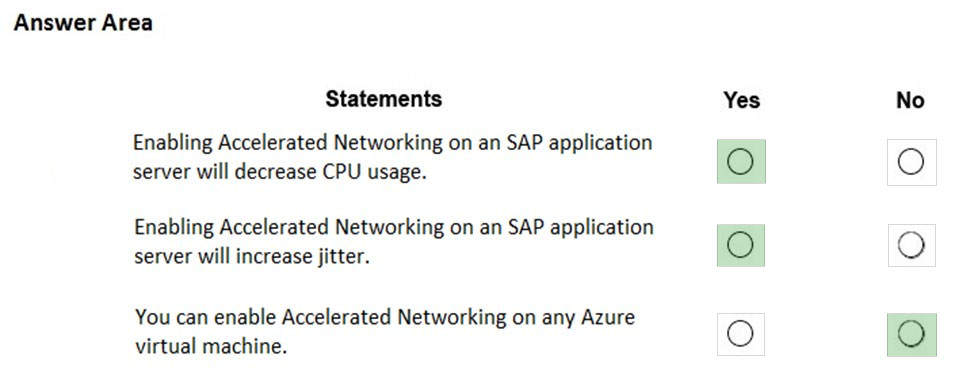
Box 1: Yes -
By moving much of Azure's software-defined networking stack off the CPUs and into FPGA-based SmartNICs, compute cycles are reclaimed by end user applications, putting less load on the VM, decreasing jitter and inconsistency in latency.
Box 2: Yes -
Box 3: No -
Accelerated Networking (AN) is generally available (GA) and widely available for Windows and the latest distributions of Linux
Reference:
https://azure.microsoft.com/en-us/blog/maximize-your-vm-s-performance-with-accelerated-networking-now-generally-available-for-both-windows-and-linux/